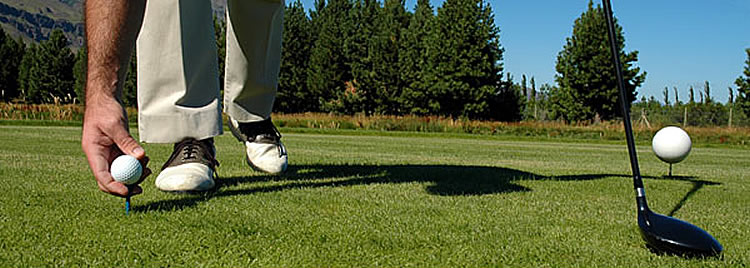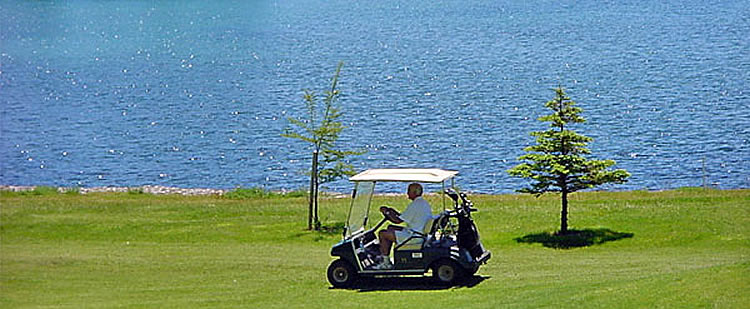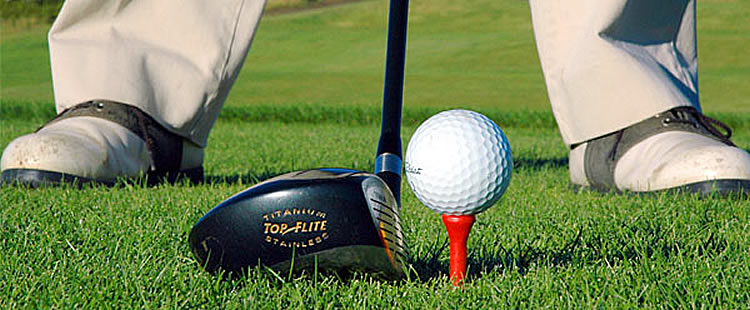Information about golf in Patagonia
Golf glossary


Ace: A hole-in-one.
Albatross: (also called a "double eagle") a score of 3 under (less than) par for a hole. For example, when a player makes a 2 on a par-5 hole.
All square: In match play competition, "all square" means the match is tied.
Approach: A short shot intended to reach the green. It is done with two special clubs: SW, which has a soft strike (also used in bunkers located close to a green) or the PW, which strikes the ball harder.

Backspin: When the ball hits the green and spins back toward the player.
Backswing: The part of the swing from the point where the clubhead moves away from the ball to the point where it starts back down again.
Birdie: Score of one under par on a hole. For example, when a score of 4 is done on a par 5.
Bogey: A score of one over par on any individual hole. For example, when a score of 6 is done on a par 5.
Ball holed: A ball is holed when it is entirely below the level of the lip of the hole
Brasie: Old name for a 2-wood.
Bunker: A hazard that is a hole or depression that has been filled in with sand or the like. A ball is in a bunker when it rests on it or is touching it.
Bye: The player who draws a "bye" is allowed to advance to the next round without playing an opponent. In match play, it is the hole or holes still left to play if the match is won before the 18th hole.

Caddie: A person whose job it is to carry the golf bag of a player during the game and assist with club selection and strategy according to the Rules.
Course: the entire area in which play is permitted.
Chip: A low short shot played from very close to the green, so that the ball rolls towards the cup.

Divot: A piece of turf dislodged by a golf swing.
Doble bogey: Score of two over par on a hole. For example, when a score of 7 is done on a par 5.
Doble Eagle: Score of three under par on a hole.
Dormie: The player who’s winning the match in match play — for example, five up with only five holes left, or four up with four left.
Dog leg: Hole on which the fairway curves one way or the other.
Draw: Shot that curves from right to left before it lands.
Drive: The first shot on a hole hit from the teeing ground. "Drive" usually refers to shots hit with a driver, 3-wood or 1-iron or driving iron; shots hit with lesser clubs (a 3-iron, for example) might be called a "tee shot" rather than a drive. The two terms are practically interchangeable. But, for example, a tee shot on a par-3 (where your club me be any iron down to a pitching wedge) is almost never called a "drive."
Drop: To deposit the ball on the course after which you put the ball back in play after it has been declared unplayable or after the ball has been lost.


Eagle: A score of two strokes below par on any individual hole. For example, when a score of 3 is done on a par 5.

Fade: Shot that curves gently from left to right.
Fairway: where the grass is cut so low that most balls can be easily played.
Finnegan: It is more than mulligan because, in addition to repeating the first shot, the player can choose either two.
Flagstick: The stick with the flag on top, which indicates the location of the cup.
Follow through: The continuation of the swing after the ball has been hit.
Foursome: Foursomes is a competition format in which teams are comprised of two players each, and the players alternate hitting the same ball. This is one of the most difficult formats for teams of two player, usually adopted for championships.

Golpe: Any swing which is completed with the intent to strike the ball, putting it into play. A swing that is voluntarily stopped prior to making contact with the ball is not a stroke.
Green: The culmination of a golf hole, where the flagstick and cup are located and where a golfer will "putt out" to end the hole. A ball is in the green when any part of it is touching the green.
Greensome: Greensomes is a competition format in which 2-person teams play one ball each. Players on a team tee off, the best of the two tee balls is selected and that ball is then played alternate-shot until holed. This format is very much used in club competitions.
Greensome-chapman: In the Chapman System, both players on a side tee off, then they switch balls. Player A plays Player B's drive, and vice-versa. Each player hits his or her second shot. They then select the best of the second shots, and from that point until the ball is holed they play only one ball in an alternate shot format. This is a more tolerant variable for the greensome, used for local prizes..
Grip: The manner in which a player holds the club. Also, the part of the shaft by which the club is held to make the swing.
Gross Score: The actual number of strokes taken by a player for hole or round before the player's handicap is deducted.

Halved: "Halved" is a match play term that means a hole or match was tied. When a hole is tied, it said to be "halved," and the players are said to have achieved a "halve." A match is halved when both players win the same number of holes.
Handicap: The number of strokes a player may deduct from his actual score to adjust his scoring ability to the level of a scratch golfer. It is designed to allow golfers of different abilities to basically compete on the same level.
Hole: 4¼ inch diameter and 4 inch deep hole in the ground into which the ball is to be played.
Honor: A player who has "honors" is the player who hits first from the tee box. On the first tee, honors can be determined randomly or by any means desired. Thereafter, the player with the lowest score on the preceding hole gets honors on the next tee.
Hook: To hit the ball in a manner that causes it to curve from right to left in the case of a right-handed player or left to right for a left hander.

Lie: The location of the ball at rest.
Lip: The edge of the hole; also to hit a putt to the edge of the hole which does not fall in.
Loft: A measurement, in degrees, of the angle at which the face of the club lies relative to a perfectly vertical face.

Markers: The objects placed at the teeing round that indicate the area in which players must tee their balls. White and yellow markers make reference to men, and red and blue markers, to women and children.
Mulligan: A second shot allowed after a poor first shot from the first tee in friendly play.

Out of Bounds: The area outside of the course in which play is prohibited. A ball is considered out of bounds when all of it is outside the boundaries. A player can stand out of bounds to play a ball resting inside the course.

Par: A number assigned to an individual hole and to the full collection of holes on a course that represents the expected number of strokes it should take to play each hole.
Pro-am: A competition which pairs professional players with amateurs.
Provisional Ball: A second ball played by a golfer who believes his first ball may be lost (but not in a water hazard) or out of bounds.
Putt: A short stroke taken on or near the green intended to put the ball in the hole, generally with a specific club, the putter. Unlike other strokes, the ball does not get off the ground. This is a very accurate stroke, as it is aimed at getting the ball into the cup. It is necessary to calculate strenght and direction in order to carry out this stroke.
Putter: A short-shafted club with a straight face for putting.


Referee: Person appointed by the Committee to escort players in order to decide upon disputes and apply the Rules. This person will take part upon any infraction observed or communicated to them. A referee is not supoosed to attend the flagstick, or stand next to or indicate the position of the hole, or hold up the ball or indicate its position.
Rough: The areas outside of fairways that generally features higher, thicker grass or naturally growing (unkept and unmowed) vegetation.

Scramble: A scramble is usually played with 4-person teams, but 2-person scrambles are popular, too. Each player tees off on each hole. The best of the tee shots is selected and all players play their second shots from that spot. The best of the second shots is determined, then all play their third shots from that spot, and so on until the ball is holed. When played as a foursome, teams are usually constructed with an A player, B player, C player and D player, with those players designated based on handicaps.
Slice: A shot that curves strongly from left to right as a result of sidespin. The converse applies to a left-handed player.
Stableford: A game format in which golfers are awarded points based on their scores in relation to a fixed score at each hole: 1 point for the bogey, two for the par, three for the birdie, four for the eagle. When the game cannot be finished in the number of strokes necessary for the scoring, the ball is picked up. This is the only format in which the winner is the player who gets the higher score. It is a faster format and it allows to pick up the ball.
Stance: The position of your feet when addressing the ball.
Swing: The action of stroking the ball.

Tee: A disposable device, normally a wooden peg, on which the ball is placed for driving.
Teeing ground: Area from which the ball is hit on the first shot of the hole. Originally a pile of sand used to elevate the ball for driving. Ball must be teed off within the markers and no more than two club lengths behind them.
Threesome: A match in which three players play a round together.
Topping: Striking the ball above the middle with the leading edge of the club, causing the ball to roll or bounce forward for only a short distance.

Up: Ahead in the match. (e.g.: one up, two up, three up, etc.).

Wedge: Generic name applied to clubs used for short shots: pitching wedge, lob wedge and sand wedge (blaster). They are short high lofted clubs intended to make the ball go high but not long.

![]()
![]()
![]()
![]()

